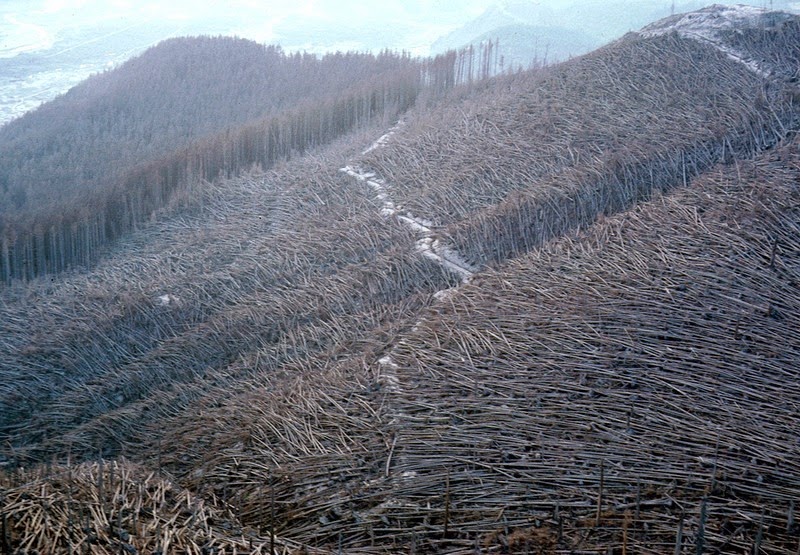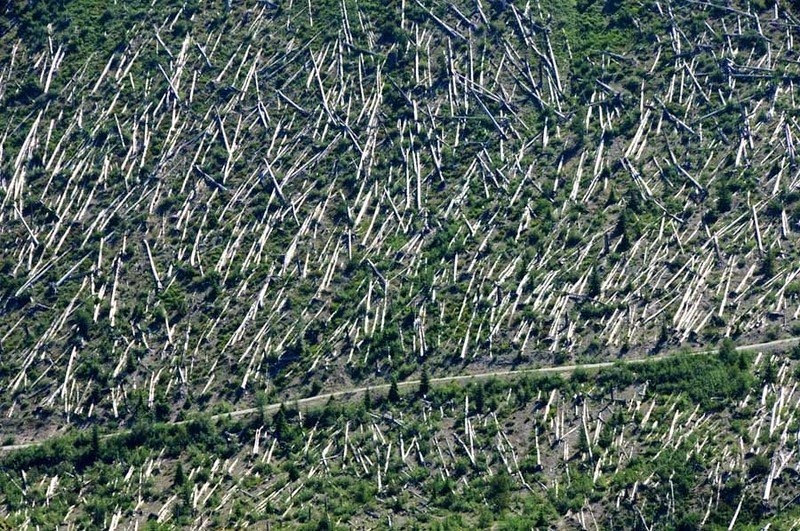The May 18, 1980 eruption of Mount St. Helens, a volcano located in state of Washington, was one of the most destructive events in the history of the United States. In just a matter of hours, the north face of the volcano collapsed creating a huge landslide - the largest debris avalanche in recorded history – that moved swiftly towards the surrounding lakes and the North Fork Toutle River valley leaving a trail of destruction 27 km long. Located only about 5 miles north-northeast of the volcanic crater, Spirit Lake received the full impact of the lateral blast.
An estimated 1 million trees were blown away from the surrounding hillside by a super-heated wall of volcanic gas and searing ash and rock, and these along with other rubble were deposited on Spirit Lake. The debris avalanche temporarily displaced much of the lake from its bed sending 600-foot-high waves crashing into a ridge north of the lake. As the water moved back into its basin, it pulled with it thousands of more trees into the lake. About 350,000 acre-feet of pyrolized trees were deposited into Spirit Lake and these shattered trees formed a floating log raft on the lake surface that is present to this day, more than three decades after the event.
A portion of the thousands of trees that remain floating in a giant raft on the surface of the lake. Photo taken on March 29, 2007. Photo credit
Prior to the eruption, Spirit Lake was a popular and picturesque body of water and was well known to many people as a vacation spot. There were six camps on the shore and a number of lodges catering to visitors.
Today, Sprit Lake is a wasteland choked with thousands of logs and volcanic debris. Huge quantities of debris decreased the lake volume by approximately 46,000 acre-feet, and its depth by 80 feet. Lahar and pyroclastic flow deposits from the eruption blocked its natural pre-eruption outlet to the North Fork Toutle River valley at its outlet, raising the surface elevation of the lake by 200 feet.
When scientists saw the mass destruction, they realised that Sprit Lake provided them with a rare opportunity to study microbial and chemical transformations and the biological restoration of a lake severely impacted by a major volcanic disturbance. To ensure protection of Spirit Lake and other recovering ecosystems inside the volcano's 220-square-mile blast area, the Mount St. Helens National Volcanic Monument was created in 1982. Fishing and other recreational activities potentially disruptive to Spirit Lake's recovery are prohibited. This is one of the primary reasons why no attempts were made to recover the logs and other forest debris floating in the lake.
The collapsed crater of Mount St. Helen with Spirit Lake in the foreground. Photo credit
Blowdown of trees from the May 18, 1980 eruption of Mount St. Helens. Elk Rock is the peak with a singed area on the left. Photo credit: USGS

Thousands of trees in the North Fork Toutle River drainage area are shown blown down by the force of the May 18, 1980, eruption of Mount St. Helens, seen on Aug. 22, 1980. Photo credit: USGS
Massive blowdown of trees in the Green River valley seen on June 2, 1980. The flattening of the forest resulted from the May 18 eruption of Mount St. Helens. Photo credit: USGS
Logs covering Spirit Lake, 2009. Photo credit
Spirit Lake log mat in 1985. Photo credit
View of Spirit Lake, southwest looking down to southern end . Blast-fell logs litter the banks or still float after the lake had been drained to maintain a safer water level since avalanche debris and trees had raised the level by several hundred feet.. Photo credit
Spirit Lake on the slopes of Mt. St. Helens in Washington State, USA. This photo was taken two years after the eruption and shows the ruined lake filled with debris from the eruption. Photo credit

A road through the blast zone. Picture taken in 2009. Photo credit
Broken stumps of trees litter the regions around Mount St. Helen. Photo credit
Sources: Wikipedia / USGS.gov / Oregonlive

























This comment has been removed by the author.
ReplyDeleteMaybe in the future beavers may come along and actually build homes or clean the lake out.
ReplyDeleteMaybe we should put beavers or some other animal on Spirit Lake and see what happens see if they try and clean it up if they start dying off then we just go pick them up and try again later i guess
DeleteAfter the eruption thousands of trees were pulled onto the lake and joined together as a floating raft. Due to huge quantities of debris the volume and depth of the lake had decreased. Also with all the destruction, Spirit lake is no longer a vacation spot. Fishing and such are prohibited while the lake is in recovery.
ReplyDeletethat is also right i dont see how the fish is living with all the ashes and things in the lake
DeleteSome changes occurred in Spirit Lake are that it is filled with trees as of now before it was a camping place now it it dead and no one camps out there. Its a dangerous place more dangerous then than now because now the fumes are down and the ash is cooled, but then the fumes were deadly and smoke and ashes were terrible. The lake is probably not livable for animals because of the ash blast. I'm sure the lake is dirty and not good for humans use either. The lake was probably dirty in the first place now the ashes have made it worse. The ash is probably the reasoning of the logs being there floating together for so long the water is probably thick.
ReplyDeleteMaybe someone can do something to help Spirit Lake go back to what it was like a camping place and vacation spot or even they can try to make it close to it.
DeleteAccording to National Geographic and scientists working in the area, Spirit Lake is full of fish and small animals. The log mat actually helped this to happen.
DeleteFrom what I've read the lake actually has recovered and is filled with trout that were stocked there. The whole area is in recovery. There is new tree growth, the lake is coming back, regardless of the log mat, animals are returning as well.
DeleteThe lake is dirty i dont see how fish are living in the lake from all the ashes. The lake is full of trash and trees now. Its not safe for humans nor animals. Yes maybe later the beavers could come build homes out of it but i dont think its safe for them to do that. The ashes and the fumes and everything that is in the lake now is all dangerous.
ReplyDeleteWhy didn't people go and try to help clean the lake up? People used to go and visit there and they banned fishing because they wanted the lake to recover but they don't do anything about all of the trees that are in it.It is dirty and it isn't safe. Its no longer a vacationing spot and that is money that they could make and use to help the reconstruction of the lake and the view. They could buy and plant trees.
ReplyDeleteAsher I heavy and settles at the bottom. This, as on land helped the plants in the lake thrive!
ReplyDelete